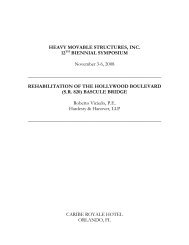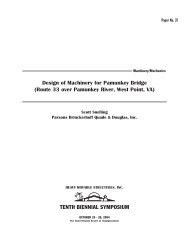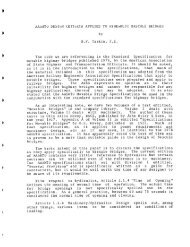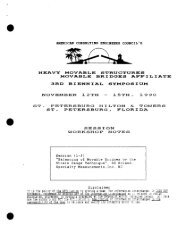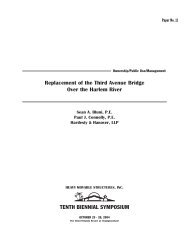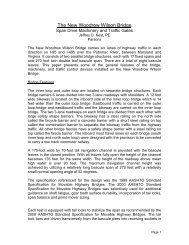State of the Art Hydraulic Systems for Movable Bridges
State of the Art Hydraulic Systems for Movable Bridges
State of the Art Hydraulic Systems for Movable Bridges
You also want an ePaper? Increase the reach of your titles
YUMPU automatically turns print PDFs into web optimized ePapers that Google loves.
Page 2~ost common means <strong>of</strong> powering movable bridges with fluidpower are:(a) <strong>Hydraulic</strong> cylinder(s) = linear motion;(b) ~ydraulic motor(s) = rotary motionEi<strong>the</strong>r means has its own unique features and both can bedepended upon to deliver about <strong>the</strong> same degree <strong>of</strong> reliablityand accuracy. The very function <strong>of</strong> <strong>the</strong> bridge itself willindicate which system you should select. Ei<strong>the</strong>r system canbe designed so that it is impervious to its environment.The retr<strong>of</strong>it <strong>of</strong> aged bridges with mechanical drives tomodern state <strong>of</strong> <strong>the</strong> art hydraulic operation is <strong>the</strong> shortestroute to life extension <strong>of</strong> <strong>the</strong> installation, and <strong>the</strong>installed cost is much lower than purchasing replacements<strong>for</strong> older mechanical drives in most cases. Most retr<strong>of</strong>itsbecome permanent installations, once <strong>the</strong> operator hasexperienced <strong>the</strong> controllability. As stated earlier, <strong>the</strong>high power to weight ratio <strong>of</strong> fluid power systems can, insome cases, allow <strong>the</strong> installation to be made along sideexisting mechanical systems, <strong>for</strong> increased serviceability orto add to <strong>the</strong> redundancy <strong>of</strong> <strong>the</strong> overall system.IV. HYDRAULIC MOTORS:~f a drive is under consideration <strong>for</strong> a new or retr<strong>of</strong>itapplication, one must consider <strong>the</strong> drive shaft or piniontorque or horsepower. Here we are dealing primarily withshaft torque. <strong>Hydraulic</strong> motors that are available todayfall into three basic categories:fa) High speed/low torque = 500 - 3600 R.P.M.cases require a speed reducer.)(Will in most(b) Low speed/high torque = 10 - 500 R.P.M. (Develops sevento nine power strokes per revolution and may require aspeed reducer.)(c) LOW speed/high torque = 0 - 50 R.P.M. (Develops up toone hundred twenty power strokes per revolution andwill not require a speed reducer.)It should be noted that on retr<strong>of</strong>it bridge applications asmaller motor may possibly be applied to existing gearing.If this is <strong>the</strong> option, in most cases it may be possible toreduce input horsepower by approximately 20% due to <strong>the</strong> highstarting torque characteristic <strong>of</strong> high torque/low speedmotors as mentioned in tc) above.




